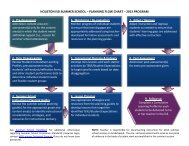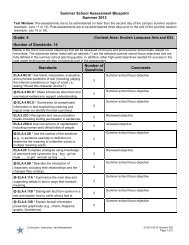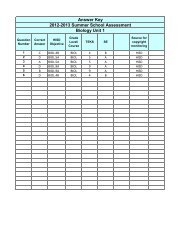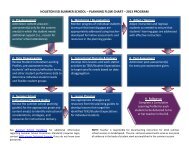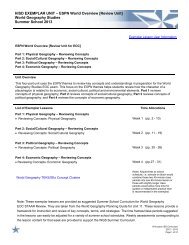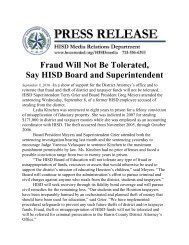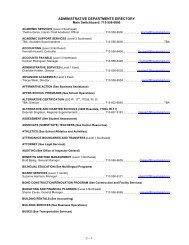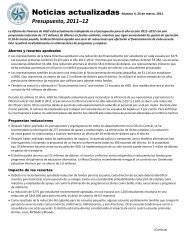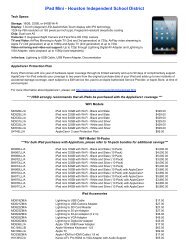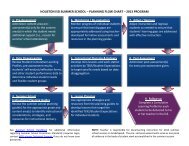Answer Key 2012-2013 Summer School Assessment Biology Unit 3
Answer Key 2012-2013 Summer School Assessment Biology Unit 3
Answer Key 2012-2013 Summer School Assessment Biology Unit 3
- No tags were found...
You also want an ePaper? Increase the reach of your titles
YUMPU automatically turns print PDFs into web optimized ePapers that Google loves.
<strong>Answer</strong> <strong>Key</strong><strong>2012</strong>-<strong>2013</strong> <strong>Summer</strong> <strong>School</strong> <strong>Assessment</strong><strong>Biology</strong> <strong>Unit</strong> 3QuestionNumberCorrect<strong>Answer</strong>HISDObjectiveGradeLevel/CourseTEKSSESource forcopyrightmonitoring1 C BIOL.8B BIOL 8 B HISD2 B BIOL.7E BIOL 7 E HISD3 D BIOL.7A BIOL 7 A HISD4 B BIOL.7A BIOL 7 A HISD5 A BIOL.7E BIOL 7 E HISD6 C BIOL.8B BIOL 8 B HISD
<strong>2012</strong>-<strong>2013</strong> HISD <strong>Summer</strong> <strong>School</strong> <strong>Assessment</strong><strong>Biology</strong> <strong>Unit</strong> 3Name1 Use the classification chart below toanswer the following question.Date2 The Hawaiian lslands are rich in diversityboth in and among species. For example,approximately two dozen honeycreeperbird species found only on the islands arethought to share a common ancestor thatimmigrated to the islands. Thedevelopment of this diversity is a result ofwhat process?To which genus would a coyote most likelybelong?ABCDThe descendants of the originalancestor mutated rapidly upon arrivalto the island.The descendants of the originalancestor adapted to a variety ofniches in the new environment.The descendants of the originalancestor became a food source for adiverse group of predators.The descendants of the originalancestor mated with birds of otherspecies and created new species.ABCDFelisPantheraCanisUrsusPage 1<strong>Biology</strong> © Houston ISD – Curriculum <strong>2012</strong> – <strong>2013</strong>
3 Cephalopods are a group of marine organisms that include modern-day squid, octopi, and thechambered nautilus. Over 7,5OO species of cephalopods are contained in the fossil record.Drawings of fossils of four different species are shown below.What does the fossil record of cephalopods indicate?ABCDAt one time, only marine organisms inhabited Earth.Cephalopods evolved into fishes over time.Changes in the environment caused mutations in the organisms.Today’s cephalopods share a common ancestry.Page 2<strong>Biology</strong> © Houston ISD – Curriculum <strong>2012</strong> – <strong>2013</strong>
4 Animals with similar traits can sometimes be found living in different locations. The beaverwhich lives in North America looks similar to the capybara in South America.How does the presence of these animals support evolutionary theory?ABCDThe presence of these animals shows that over a period of millions of years, humansthat hunted these animals increased their habitation areas.The presence of these animals shows that although they are found in different areas,beavers and capybara arose from a common ancient ancestor.The presence of these animals shows that beavers and capybara share the samemigration route.The presence of these animals shows that Earth was at one time inhabited only bymammals.Page 3<strong>Biology</strong> © Houston ISD – Curriculum <strong>2012</strong> – <strong>2013</strong>
5 A new species of vine is inadvertentlyintroduced into a forest by campers. Thevine grows quickly up the trunks of nativetrees, gradually killing them by interruptingthe growth of branches and leaves. Whatbest describes how natural selection willaffect the population of trees in this forest?6 The diagram below illustrates therelationships between different species ofCanidae.ABCDTrees that are best adapted tocompete with the vine will survive andpass their existing adaptations tooffspring.Offspring of the trees will begenetically identical.The vines and trees will interbreed toproduce a new species.New adaptations will appear in adulttrees that allow them to outcompetethe vine.Based on the diagram, which species hasthe least structural or physiologicalsimilarities to the other organisms on thediagram?ABCDCoyoteRaccoon dogBlack bearBat-eared foxBE SURE YOU HAVE RECORDED ALL OF YOURANSWERS ON THE ANSWER DOCUMENTPage 4<strong>Biology</strong> © Houston ISD – Curriculum <strong>2012</strong> – <strong>2013</strong>




